“Its face, speed, power, and shape put it in league with world-class breaks—something no other artificial wave has managed before”: on the possibility of a perfect artificial wave created for competitive surfing.
Tag: Hydrology
Water & Power
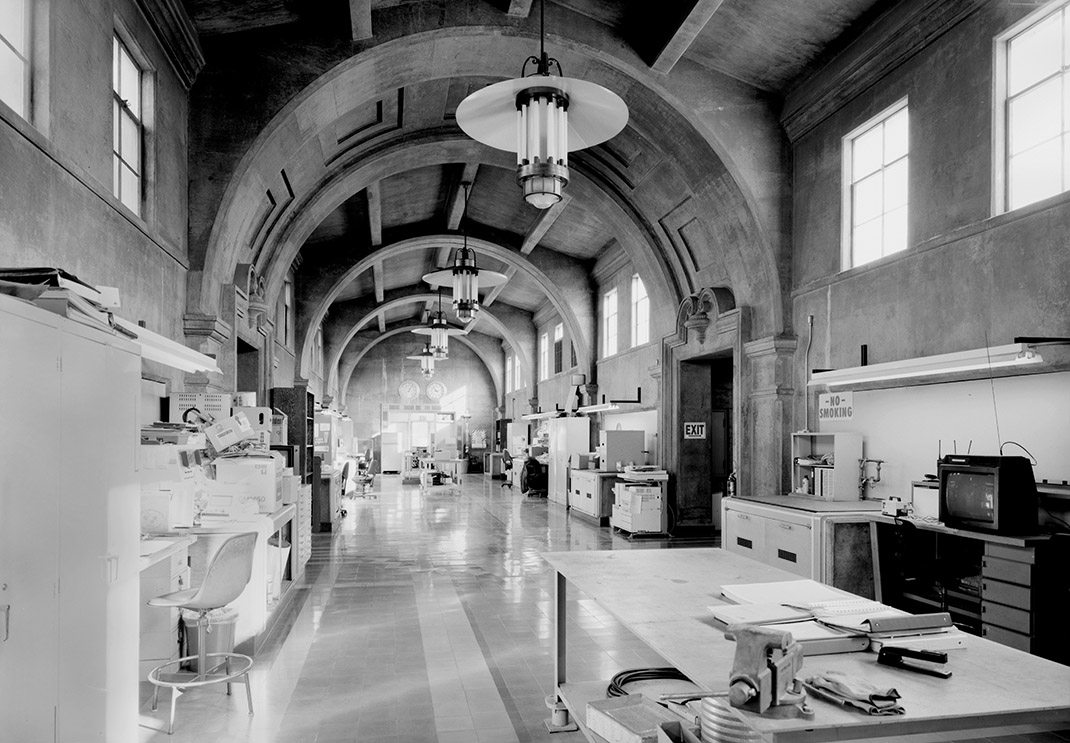 [Image: Via the Library of Congress].
[Image: Via the Library of Congress].
While going through a bunch of old photos of Los Angeles on the Library of Congress website for a project I’m doing at USC this year, I was amazed by these interior shots of the F. E. Weymouth Filtration Plant at 700 North Moreno Avenue in L.A.
Despite being designed for the administration of an urban water-processing site, the interiors seem to play with some strange, Blade Runner-like variation on Byzantine modernism, where federalist detailing meets a hydrological Babylon.
 [Image: Via the Library of Congress].
[Image: Via the Library of Congress].
As the open plan interior of a contemporary home, this place would almost undoubtedly show up on every design website today—imagine a better railing on the central staircase, a galley kitchen on one side, a bed lit by retro-styled fluorescent tubes at the far end, some bold moments of color—but it’s just a piece of everyday municipal infrastructure.
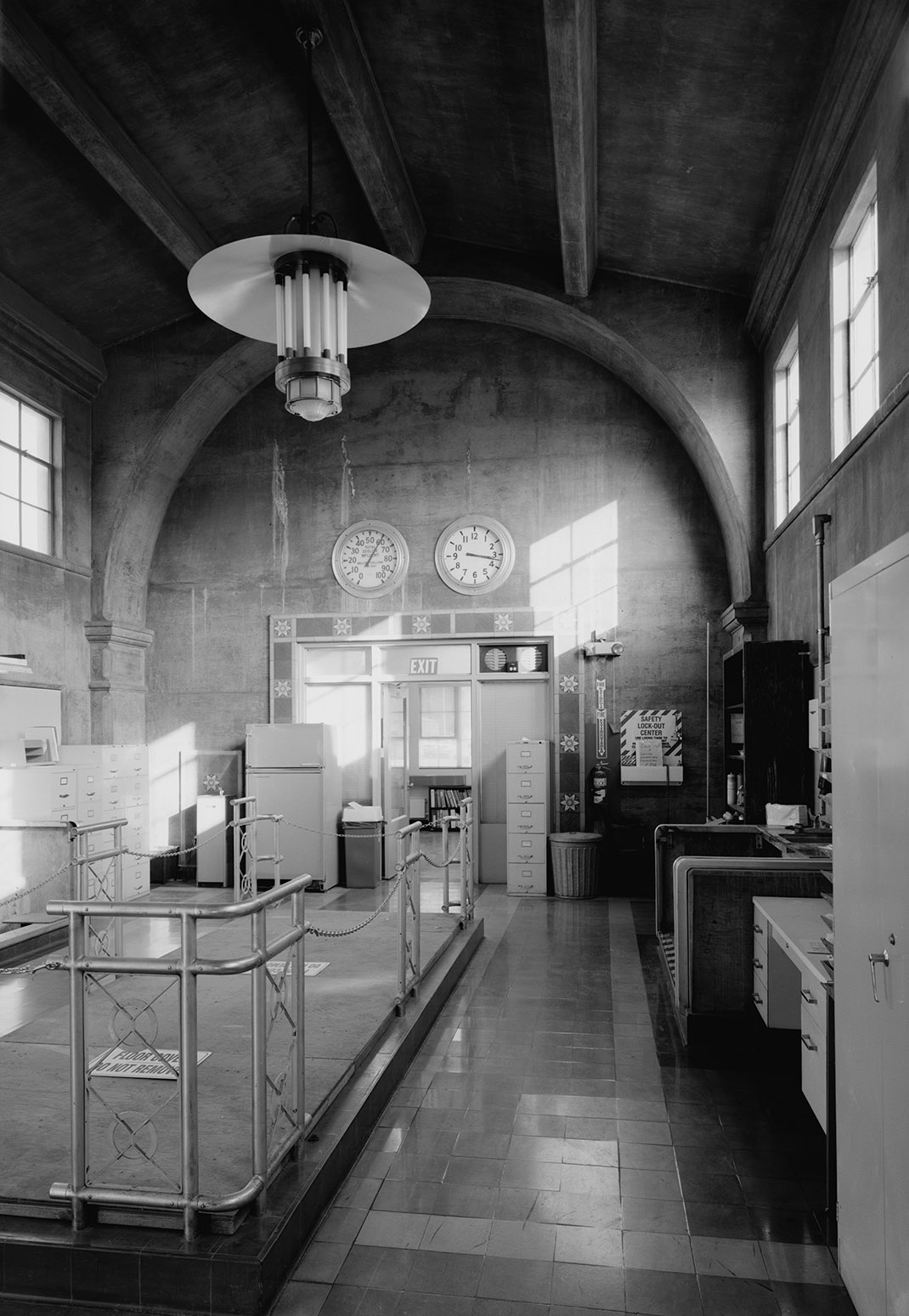 [Image: Via the Library of Congress].
[Image: Via the Library of Congress].
In any case, continuing the vaguely sci-fi feel, there is even a tiled fountain—a Mediterranean concession to the building’s role in water filtration—on one wall, emphasized by these amazing lighting features, yet it looks more like a film set, both ancient and futuristic.
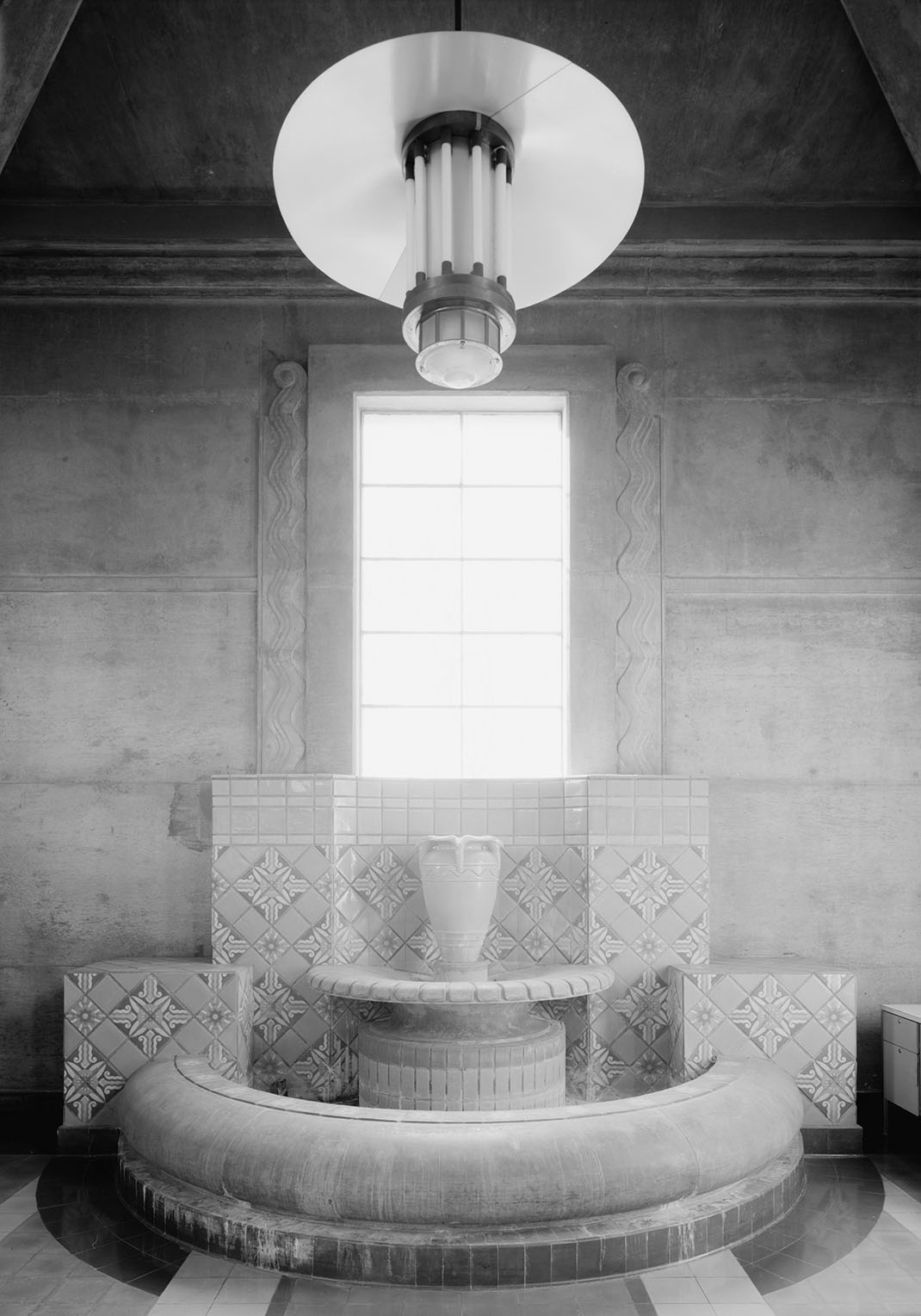 [Image: Via the Library of Congress].
[Image: Via the Library of Congress].
Alas, I’m not a huge fan of the exterior, although it is, in fact, a fairly amazing example of municipal design gone more sacred than profane. But an equally streamlined modernism in keeping with those interiors would have made this place totally otherworldly.
 [Image: From the Library of Congress].
[Image: From the Library of Congress].
Finally, the marbled lobbies continue the surreal mix-up of styles, eras, and materials with something that could perhaps be described as Aztec corporatism with its huge graphic seal and other geometric motifs.
 [Image: From the Library of Congress].
[Image: From the Library of Congress].
For shots of the actual waterworks, click through to the Library of Congress.
Abandoned Basements as Stormwater Basins
 [Image: Rendering of a possible “BaseTern” landscape by students Brett Harris, Andrew D’Arcy, and Heidi Petersen, via Landscape Architecture Magazine].
[Image: Rendering of a possible “BaseTern” landscape by students Brett Harris, Andrew D’Arcy, and Heidi Petersen, via Landscape Architecture Magazine].
Not all the news coming out of Milwaukee involves misguided highway megaprojects or tax-funded crony capitalism—though there is that.
For example, Wisconsin governor Scott Walker—confusing an earlier generation’s urban mistakes with how a city is meant to function—has been plowing billions of dollars’ worth of taxpayer money into “freeway megaprojects” for which “the pricetag got so big that leaders from his own party rejected his plan as fiscally irresponsible, leaving the state budget in limbo,” Politico reports:
As the state has shifted resources into freeway megaprojects, 71 percent of [Wisconsin’s] roads are in mediocre or poor condition, according to federal data. Fourteen percent of its bridges are structurally deficient or functionally obsolete, which is actually better than the national average. Walker and his fellow Republicans have killed plans for light rail, commuter rail, high-speed rail, and dedicated bus lanes on major highways, so there is almost no public transportation connecting Milwaukee to its suburbs, intensifying divisions in one of the nation’s most racially, economically and politically segregated metropolitan areas. Yet Walker, who is running for president as a staunch fiscal conservative, has pushed a $250 million-per-mile plan to widen Interstate 94 between the Marquette and the Zoo despite fierce local opposition.
If that sounds both avoidable and unfortunate, consider the fact that “Walker also killed a ‘Complete Streets’ program that pushed road builders to accommodate bicyclists and pedestrians.”
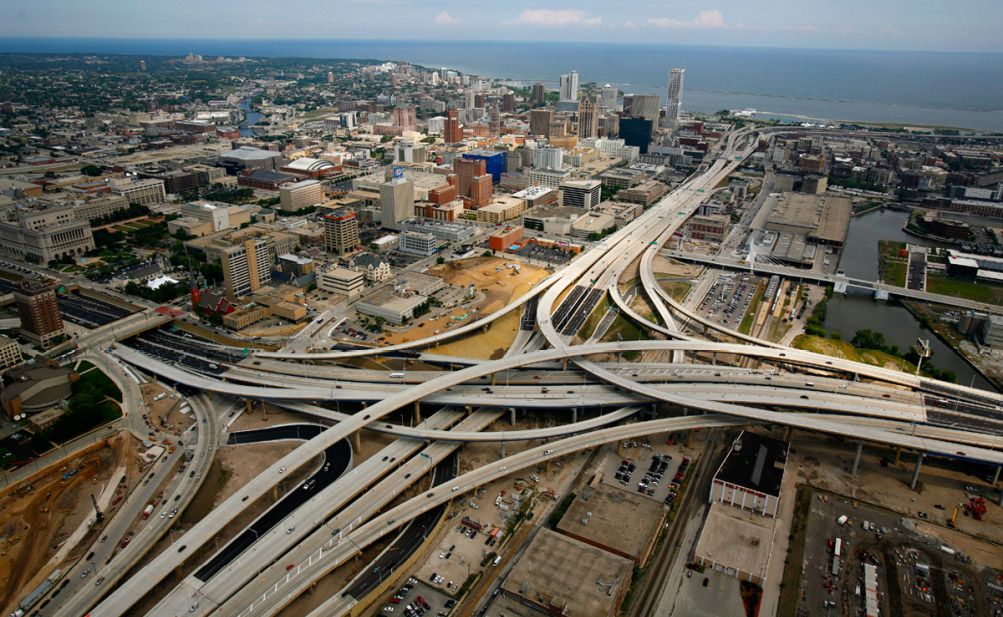
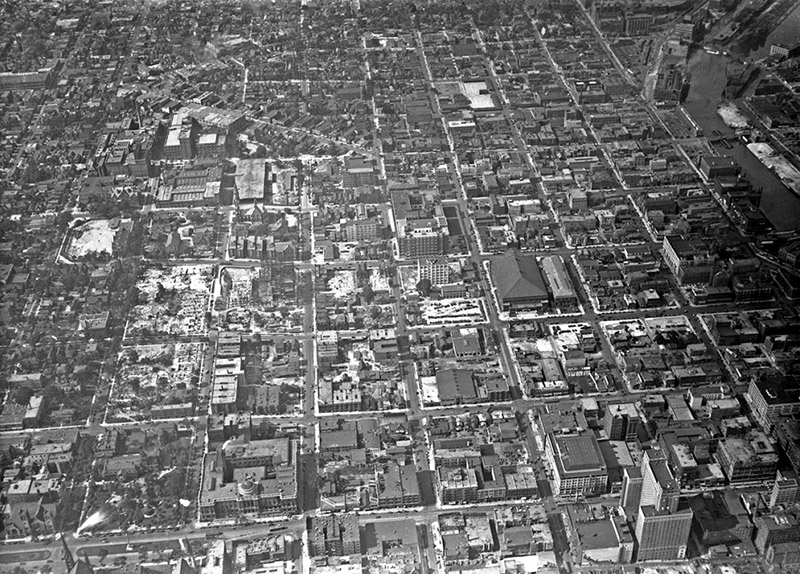 [Images: (top) Milwaukee’s Marquette interchange, nearly the same size as the city it cuts through; (bottom) Milwaukee before the interchange. Images via Politico].
[Images: (top) Milwaukee’s Marquette interchange, nearly the same size as the city it cuts through; (bottom) Milwaukee before the interchange. Images via Politico].
At the same time, Walker has also “championed a high-profile proposal to spend a quarter of a billion dollars of taxpayer money to help finance a new Milwaukee Bucks arena—all while pushing to slash roughly the same amount from state funding for higher education,” the International Business Times reports.
But, hey, why does Wisconsin need universities when everyone can just go to an NBA game? Not that benefitting the public is even Walker’s goal: “One of those who stands to benefit from the controversial initiative is a longtime Walker donor and Republican financier who has just been appointed by the governor to head his presidential fundraising operation.”
In any case, an interesting landscape test-project is currently underway in Milwaukee, called the “BaseTern” program.
As the city explains it, a “BaseTern” is “an underground stormwater management or rainwater harvesting structure created from the former basement of an abandoned home that has been slated for demolition.” Why is the city doing this?
By using abandoned basements, the City saves the cost of demolition on these structures (filing the basement and grading the surface) and on excavation for the new structure. In addition, BaseTerns provide significant stormwater storage capacity on a single site, the equivalent of up to 600 rain barrels.
The result, the city is keen to add, is “not an open pit. Rather a BaseTern is a covered structure, which is covered with topsoil and grass, and will appear the same as conventional vacant lot.”
In their July 2015 issue, Landscape Architecture Magazine explained that this is, in fact, “the world’s first such system.” Conceived—and actually trademarked—by a city official named Erick Shambarger, the idea was inspired by a GIS-fueled discovery that the worst flooding in the city always “occurred in neighborhoods with high rates of foreclosures. The city controls roughly 900 foreclosed properties, many of which it plans to demolish. Shambarger figured the city could preserve the basement structure and put it to use.”
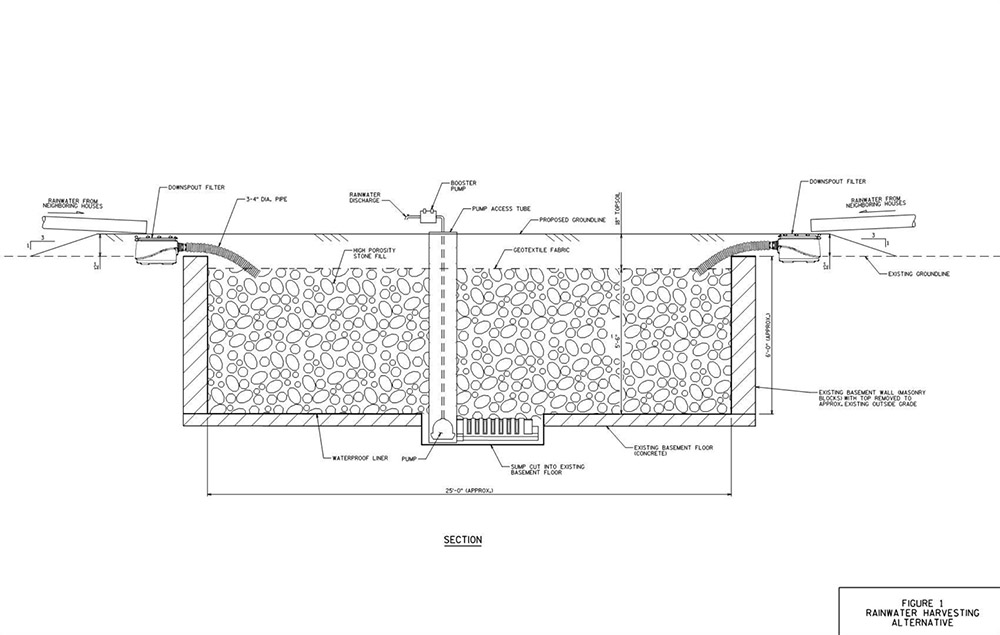
 [Images: Two BaseTern design diagrams, taken from Milwaukee’s “Vacant Basements for Stormwater Management Feasibility Study“].
[Images: Two BaseTern design diagrams, taken from Milwaukee’s “Vacant Basements for Stormwater Management Feasibility Study“].
While there is something metaphorically unsettling in the idea that parts of a blighted, financially underwater neighborhood might soon literally be underwater—transformed into a kind of urban sponge for the rest of Milwaukee—the notion that the city can discover in its own economic misfortune a possible new engineering approach for dealing with seasonal flooding and super-storms is an inspiring thing to see.
The BaseTern program also potentially suggests a stopgap measure for coastal cities set to face rising sea levels well within the lifetimes of the coming generation.
In the all but inevitable managed retreat from the coast that seems set to kick off both en masse and in earnest by midcentury—something that is already happening in New York City, post-Sandy—perhaps the subterranean ruins of old neighborhoods left behind can be temporarily repurposed as minor additions to a broader coastal program intent on reducing flooding for residents further inland.
Before, of course, those underground voids—former guest bedrooms, dens, man caves, she sheds, and basements—are inundated for good.
Read more about BaseTerns over at Landscape Architecture Magazine.
Joyful Rendezvous Upon Pure Ice and Snow
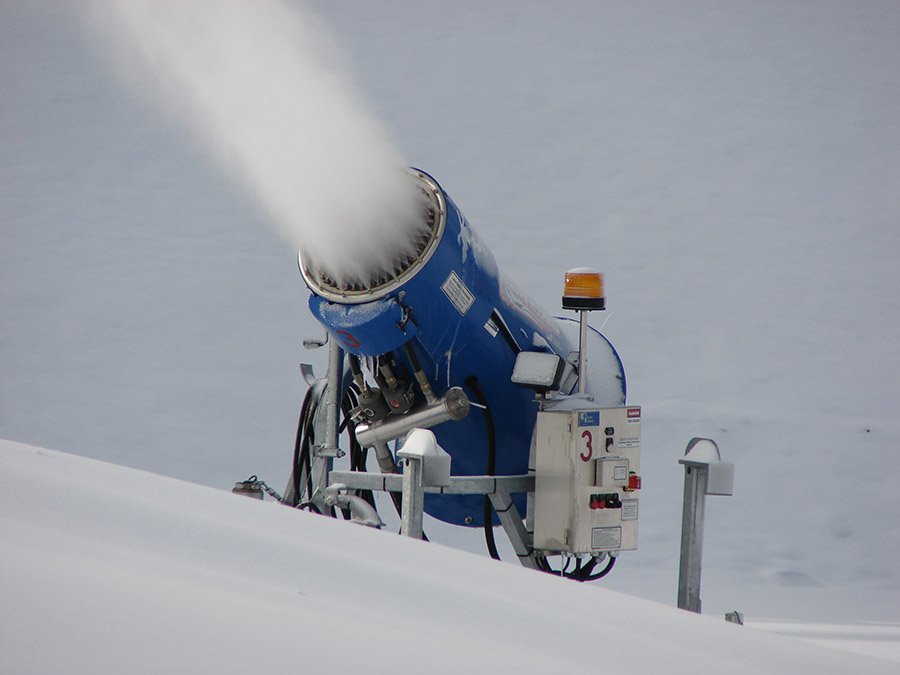 [Image: Snow-making equipment via Wikipedia].
[Image: Snow-making equipment via Wikipedia].
The 2022 Winter Olympics in Beijing are something of a moonshot moment for artificial snow-making technology: the winter games will be held “in a place with no snow.” That’s right: “the 2022 Olympics will rely entirely on artificial snow.”
As a report released by the International Olympic Committee admits, “The Zhangjiakou and Yanqing Zones have minimal annual snowfall and for the Games would rely completely on artificial snow. There would be no opportunity to haul snow from higher elevations for contingency maintenance to the racecourses so a contingency plan would rely on stockpiled man-made snow.”
This gives new meaning to the word snowbank: a stock-piled reserve of artificial landscape effects, an archive of on-demand, readymade topography.
Beijing’s slogan for their Olympic bid? “Joyful Rendezvous upon Pure Ice and Snow.”
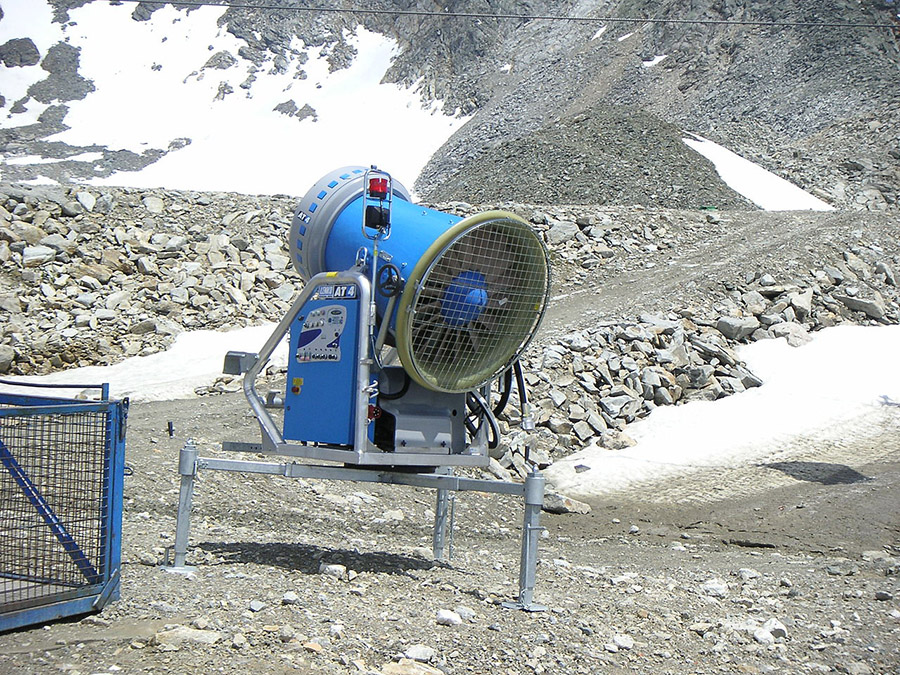 [Image: Snow-making equipment via Wikipedia].
[Image: Snow-making equipment via Wikipedia].
Purely in terms of energy infrastructure and freshwater demand—most of the water will be pumped in from existing reservoirs—the 2022 winter games will seemingly be unparalleled in terms of their sheer unsustainability. Even the IOC sees this; from their report:
The Commission considers Beijing 2022 has underestimated the amount of water that would be needed for snowmaking for the Games but believes adequate water for Games needs could be supplied.
In addition, the Commission is of the opinion that Beijing 2022 has overestimated the ability to recapture water used for snowmaking. These factors should be carefully considered in determining the legacy plans for snow venues.
Knowing all this, then, why not be truly radical—why not host the winter games in Florida’s forthcoming “snowball fight arena,” part of “a $309 million resort near Kissimmee that would include 14-story ski and snowboard mountain, an indoor/outdoor skateboard park and a snowball fight arena”?
Why not host them in Manaus?
Interestingly, the IOC also raises the question of the Games’ aesthetics, warning that the venues might not really look like winter.
“Due to the lack of natural snow,” we read, “the ‘look’ of the venue may not be aesthetically pleasing either side of the ski run. However, assuming sufficient snow has been made or stockpiled and that the temperature remains cold, this should not impact the sport during the Games.”
Elsewhere: “There could be no snow outside of the racecourse, especially in Yanqing, impacting the visual perception of the snow sports setting.” This basically means that there will be lots of bare ground, rocks, and gravel lining the virginal white strips of these future ski runs.
 [Image: Ski jumping in summer at Chicago’s Soldier Field (1954); via Pruned].
[Image: Ski jumping in summer at Chicago’s Soldier Field (1954); via Pruned].
Several years ago, Pruned satirically offered Chicago as a venue for the world’s “first wholly urban Winter Olympics.” With admirable detail, he went into many of the specifics for how Chicago might pull it off, but he also points out the potential aesthetic disorientation presented by seeing winter sports in a non-idyllic landscape setting.
“Chicago’s gritty landscape shouldn’t be much of a handicap,” he suggests. Chicago might not “embody a certain sort of nature—rustic mountains, pastoral evergreen forests, a lonely goatherd, etc.,” but the embedded landscape technology of the Winter Games should have left behind that antiquated Romanticism long ago.
As Pruned asks, “have the more traditional Winter Olympic sites not been over the years transformed into high-tech event landscapes, carefully managed and augmented with artificial snow and heavy plows that sculpt the slopes to a pre-programmed set of topographical parameters?”
Seen this way, Beijing’s snowless winter games are just an unsustainable historical trajectory taken to its most obvious next step.
 [Image: Making snow for It’s A Wonderful Life, via vintage everyday].
[Image: Making snow for It’s A Wonderful Life, via vintage everyday].
In any case, the 2022 Winter Olympics are shaping up to be something like an Apollo Program for fake snow, an industry that, over the next seven years, seems poised to experience a surge of innovation as the unveiling of this most artificial of Olympic landscapes approaches.
Lost Lakes of the Empire State Building
 [Image: Sunfish Pond].
[Image: Sunfish Pond].
Something I’ve meant to post about for awhile—and that isn’t news at all—is the fact that there is a lost lake in the basement of the Empire State Building. Or a pond, more accurately speaking.
After following a series of links leading off from Steve Duncan’s ongoing exploration of New York’s “lost streams, kills, rivers, brooks, ponds, lakes, burns, brakes, and springs,” I found the fascinating story of Sunfish Pond, a “lovely little body of water” at the corner of what is now 31st Street and Fourth Avenue. “The pond was fed both by springs and by a brook which also carried its overflow down to the East River at Kip’s Bay.”
Interestingly, although the pond proper would miss the foundations of the Empire State Building, its feeder streams nonetheless pose a flood risk to the building: the now-buried waterway “leading from Sunfish Pond still floods the deep basement of the Empire State Building today.”
To a certain extent, this reminds me of a line from the recent book Alphaville: “Heat lightning cackles above the Brooklyn skyline and her message is clear: ‘You may have it paved over, but it’s still a swamp.'” That is, the city can’t escape its hydrology.
But perhaps this makes the Empire State Building as good a place as any for us to test out the possibility of fishing in the basements of Manhattan: break in, air-hammer some holes through the concrete, bust out fishing rods, and spend the night hauling inexplicable marine life out of the deep and gurgling darkness below.
Infrastructural Opportunism
 [Image: From Coupling: Strategies for Infrastructural Opportunism by Lateral Office/InfraNet Lab].
[Image: From Coupling: Strategies for Infrastructural Opportunism by Lateral Office/InfraNet Lab].
Going all the way back to the fall of 1997, my own interest in architecture was more or less reinvigorated—leading, by way of a long chain of future events, to the eventual start of BLDGBLOG—by Mary-Ann Ray’s installment in the great Pamphlet Architecture series, Seven Partly Underground Rooms and Buildings for Water, Ice, and Midgets.
To this day, the pamphlet format—short books, easily carried around town, packed with spatial ideas and constructive speculations—remains inspiring.
The 30th installment in this canonical series is thankfully a great one, authored by Lateral Office and InfraNet Lab, a design firm and its attendant research blog that I’ve been following for many years.
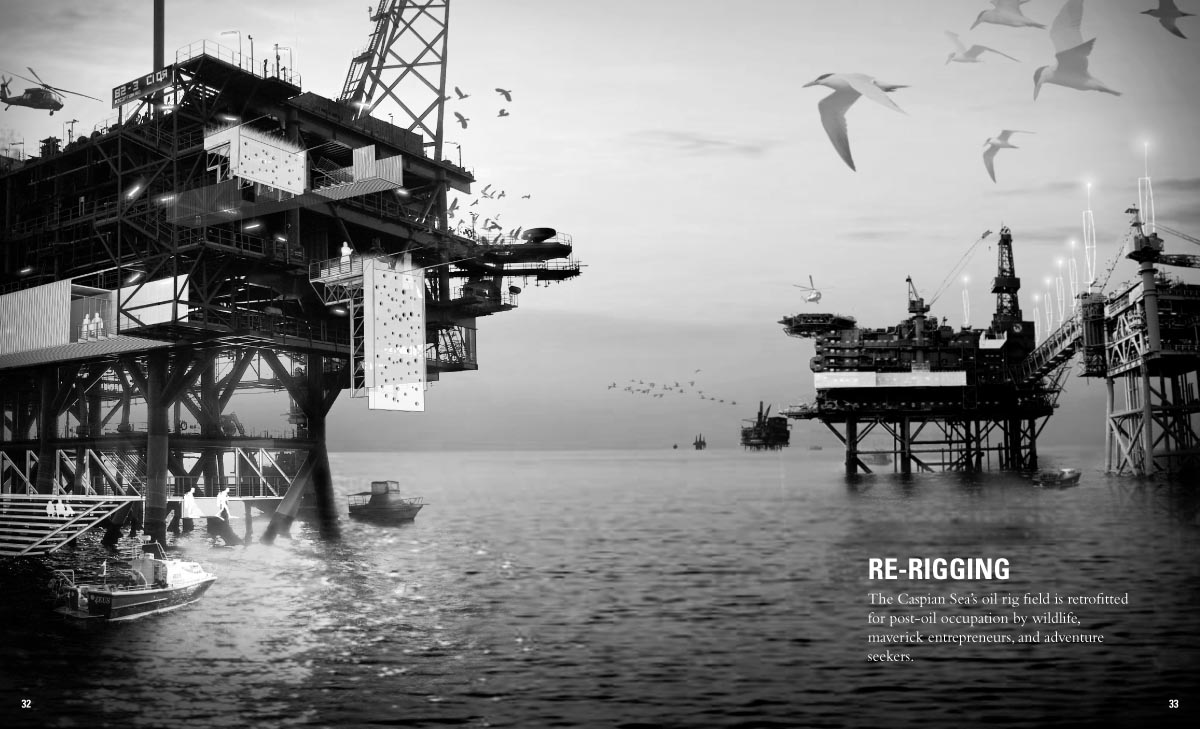 [Image: From Coupling: Strategies for Infrastructural Opportunism by Lateral Office/InfraNet Lab].
[Image: From Coupling: Strategies for Infrastructural Opportunism by Lateral Office/InfraNet Lab].
The premise of the work documented by their book, Coupling: Strategies for Infrastructural Opportunism, is to seek out moments in which architecturally dormant landscapes, from the Arctic Circle to the Salton Sea, can be activated by infrastructure and/or spatially reused. Their work is thus “opportunistic,” as the pamphlet’s title implies. It is architecture at the scale of infrastructure, and infrastructure at the scale of hemispheres and ecosystems—the becoming-continental of the architecture brief.
In the process, their proposed interventions are meant to augment processes already active in the terrain in question—processes that remain underutilized or, rather, below the threshold of spatial detection.
As the authors themselves describe it, these projects “double as landscape life support, creating new sites for production and recreation. The ambition is to supplement ecologies at risk rather than overhaul them.”

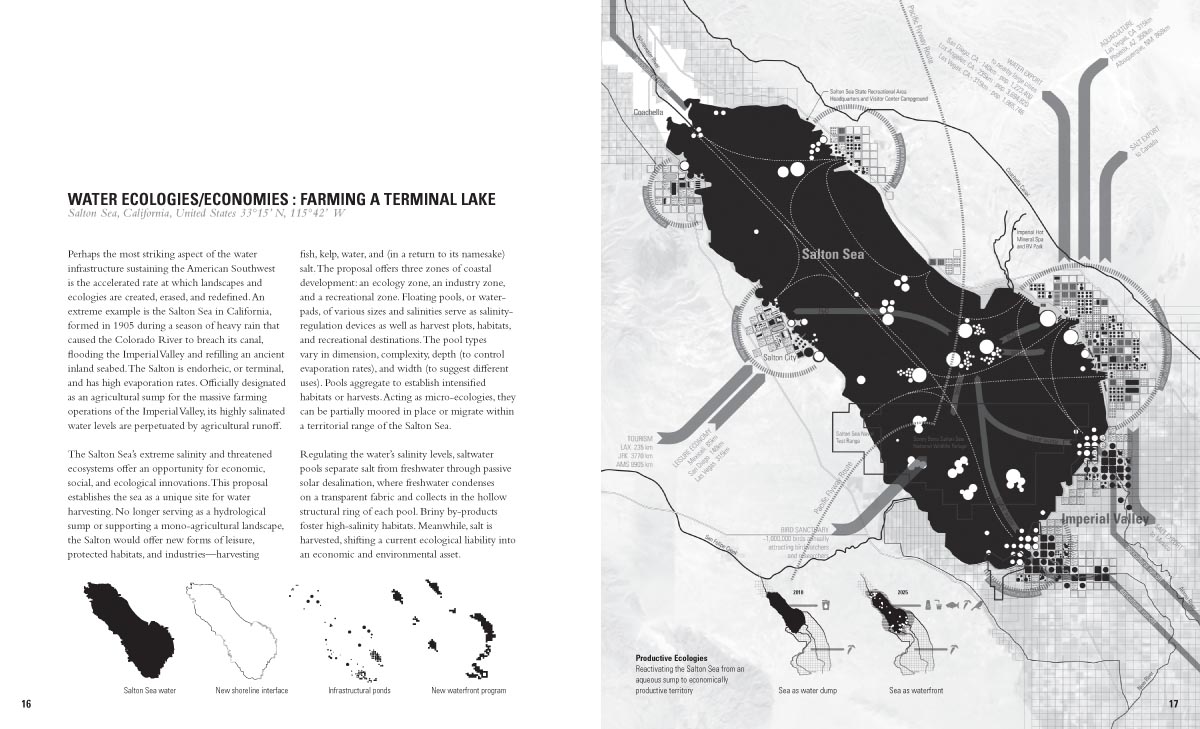
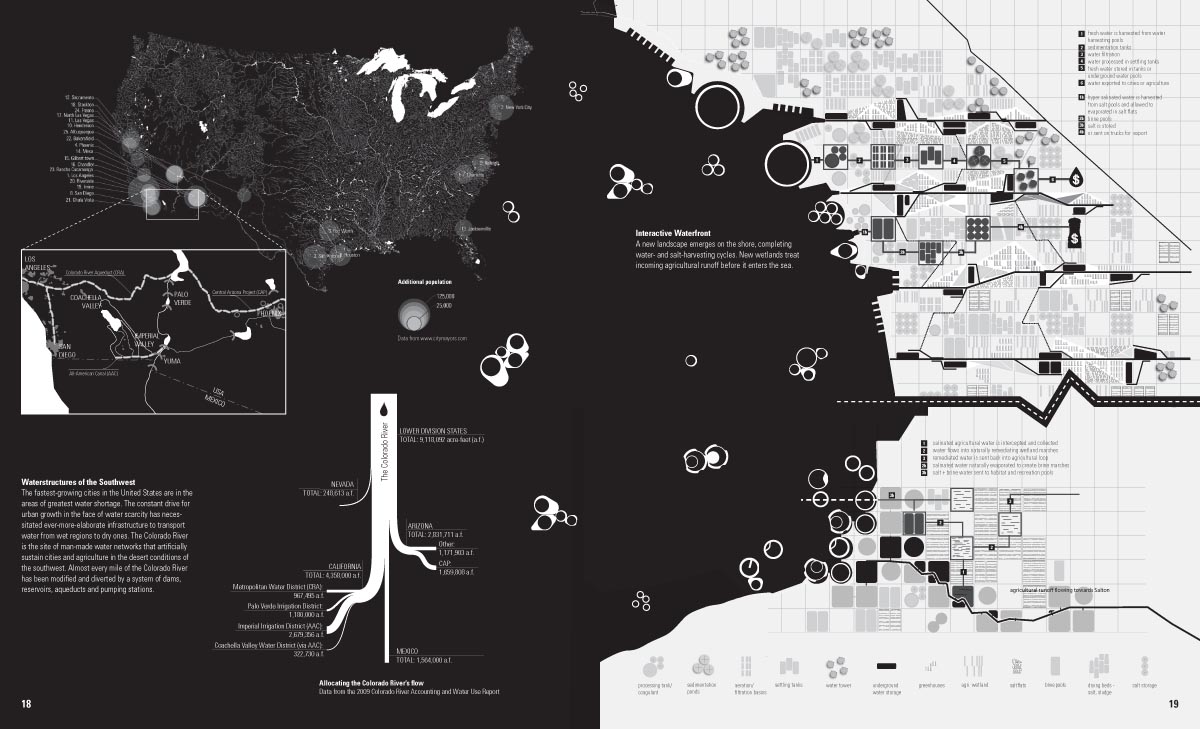 [Images: From Coupling: Strategies for Infrastructural Opportunism by Lateral Office/InfraNet Lab].
[Images: From Coupling: Strategies for Infrastructural Opportunism by Lateral Office/InfraNet Lab].
One of the highlights of the book for me is a section on the so-called “Next North.” Here, they offer “a series of proposals centered on the ecological and social empowerment of Canada’s unique Far North and its attendant networks.”
Throughout the twentieth century, the Canadian North had a sordid and unfortunate history of colonial enterprises, political maneuverings, and non-integrated development proposals that perpetuated sovereign control and economic development. Northern developments are intimately tied to the construction of infrastructure, though these projects are rarely conceived with a long-term, holistic vision. How might future infrastructures participate in cultivating and perpetuating ecosystems and local cultures, rather than threatening them? How might Arctic settlements respond more directly to the exigencies of this transforming climate and geography, and its ever-increasing pressures from the South? What is next for the North?
Three specific projects follow. One outlines the technical possibility of building “Ice Road Truck Stops.” These would use “intersecting meshes,” almost as a kind of cryotechnical rebar, inserted into the frozen surfaces of Arctic lakes to “address road reinforcement, energy capture, and aquatic ecologies.”
The mesh is installed at critical shorelines just below the water’s surface, serving to reinforce ice roads during the winter and invigorate lake ecologies during warmer seasons. As trucks travel over the ice road, a hydrodynamic wave forms below the ice, which the mesh captures and converts to energy through a proposed buoy network.
There is then a series of “Caribou Pivot Stations”—further proof that cross-species design is gathering strength in today’s zeitgeist—helping caribou to forage for food on their seasonal migrations; and a so-called “Liquid Commons,” which is a “malleable educational infrastructure composed of a series of boats that travel between the harbors of eleven adjacent communities.” It is a mobile, nomadic network bringing tax-funded educational opportunities to the residents of this emerging Next North.


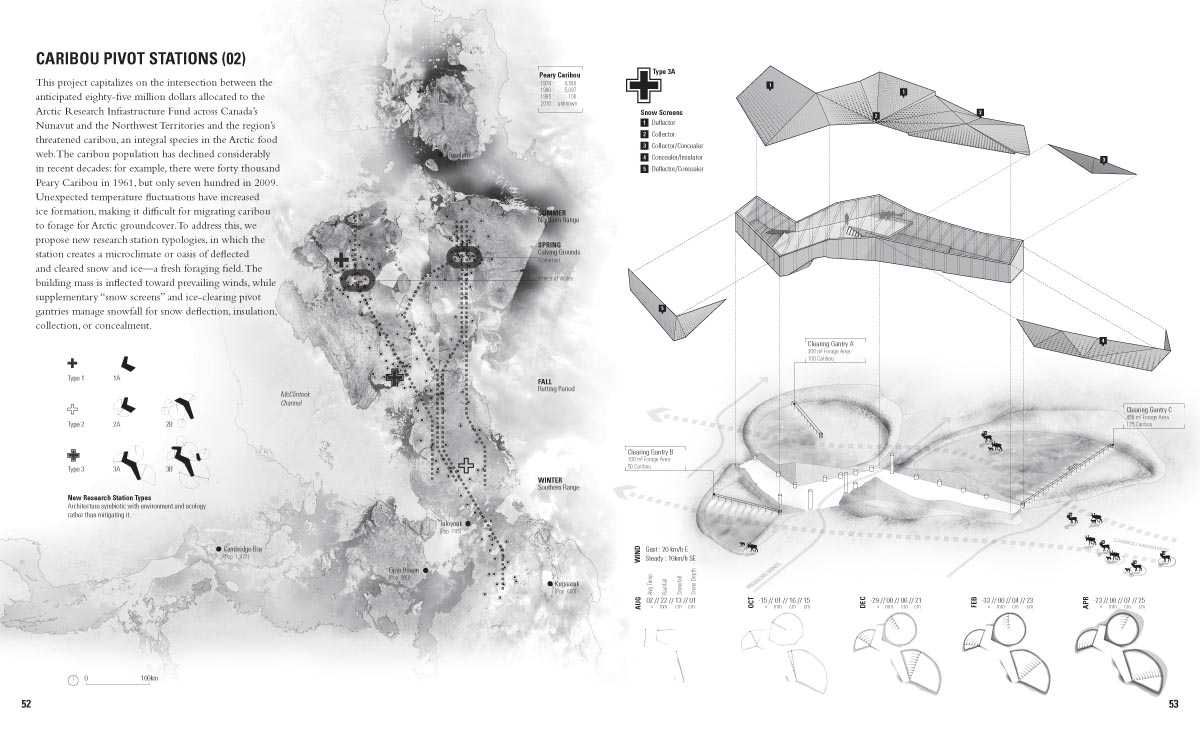
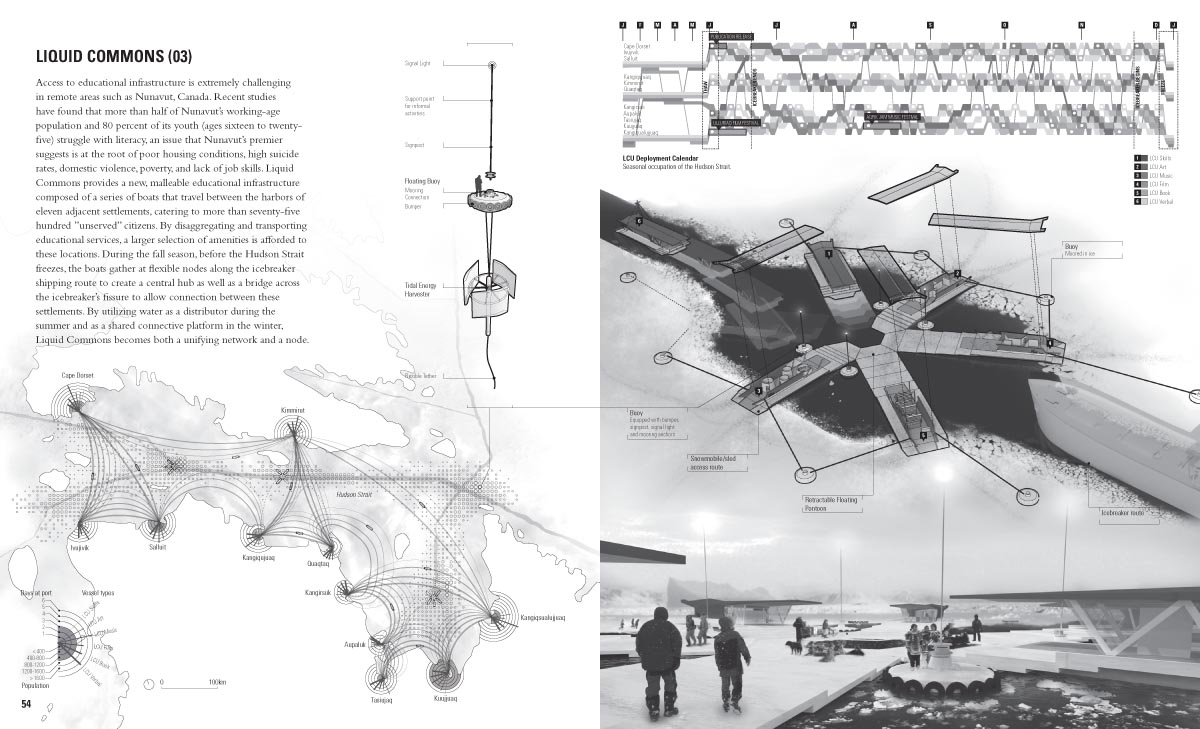 [Images: From Coupling: Strategies for Infrastructural Opportunism by Lateral Office/InfraNet Lab].
[Images: From Coupling: Strategies for Infrastructural Opportunism by Lateral Office/InfraNet Lab].
Here, I should point out that the book has an air of earnestness—everything is very serious and technical and not to be laughed at—but the projects themselves often belie this attitude. It’s as if the authors are aware of, and even revel in, the speculative nature of their ideas, but seem somehow rhetorically unwilling to give away the game. But the implication that these projects are eminently buildable—shovel-ready projects just waiting for a financial green light to do things like “cultivate” ice in the Bering Strait (duly illustrated with a Photoshopped walrus) or “harvest” water from the Salton Sea—is a large part of what makes the book such an enjoyable read.
After all, does presenting speculative work as if it could happen tomorrow—as if it is anything but speculative—increase its architectural value? Or should such work always hold itself at an arm’s length from realizability, so as to highlight its provocative or polemical tone?
The projects featured in Coupling have an almost tongue-in-cheek buildability to them—such as recreational climbing walls on abandoned oil platforms in the Caspian Sea. This opens a whole slew of important questions about what rhetorical mode—what strategy of self-presentation—is most useful and appropriate for upstart architectural firms. (At the very least, this would make for a fascinating future discussion).
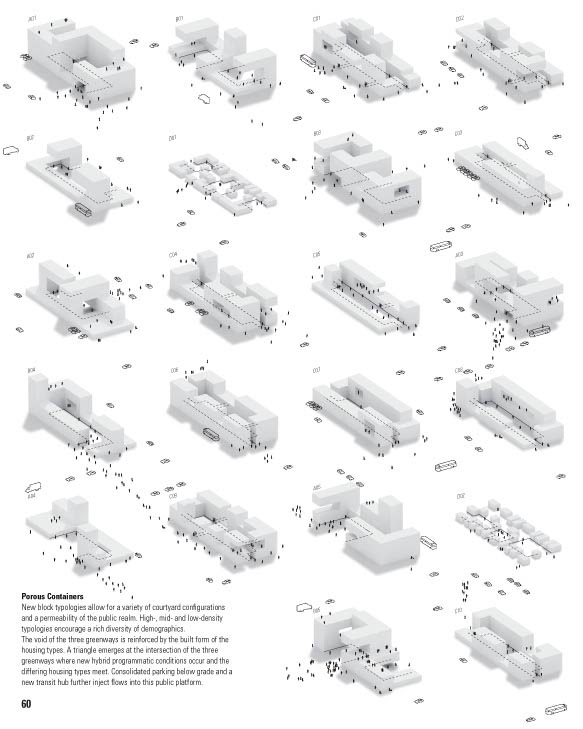 [Image: From Coupling: Strategies for Infrastructural Opportunism by Lateral Office/InfraNet Lab].
[Image: From Coupling: Strategies for Infrastructural Opportunism by Lateral Office/InfraNet Lab].
In any case, the book is loaded with diagrams, as you can see from the selections reproduced here, including a volumetric study (above) that runs through various courtyard typologies for a hypothetical mixed-use project in Iceland. For more on that particular work, see this older, heavily-illustrated BLDGBLOG post.
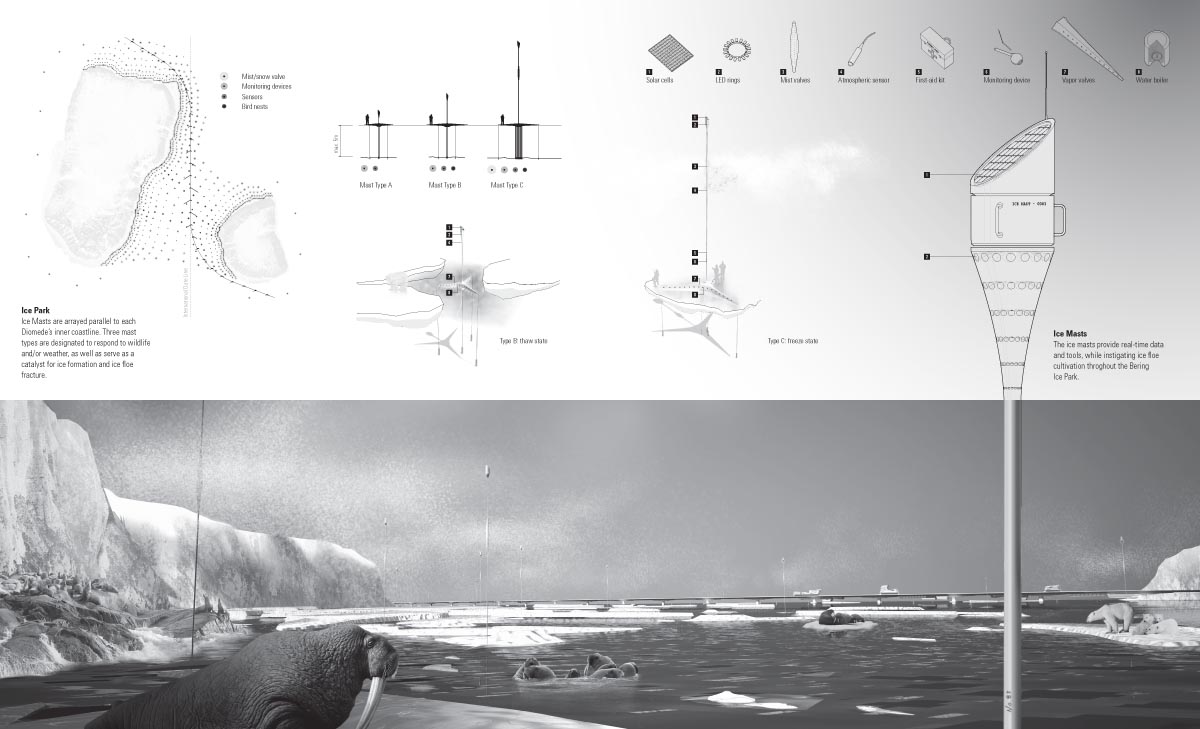
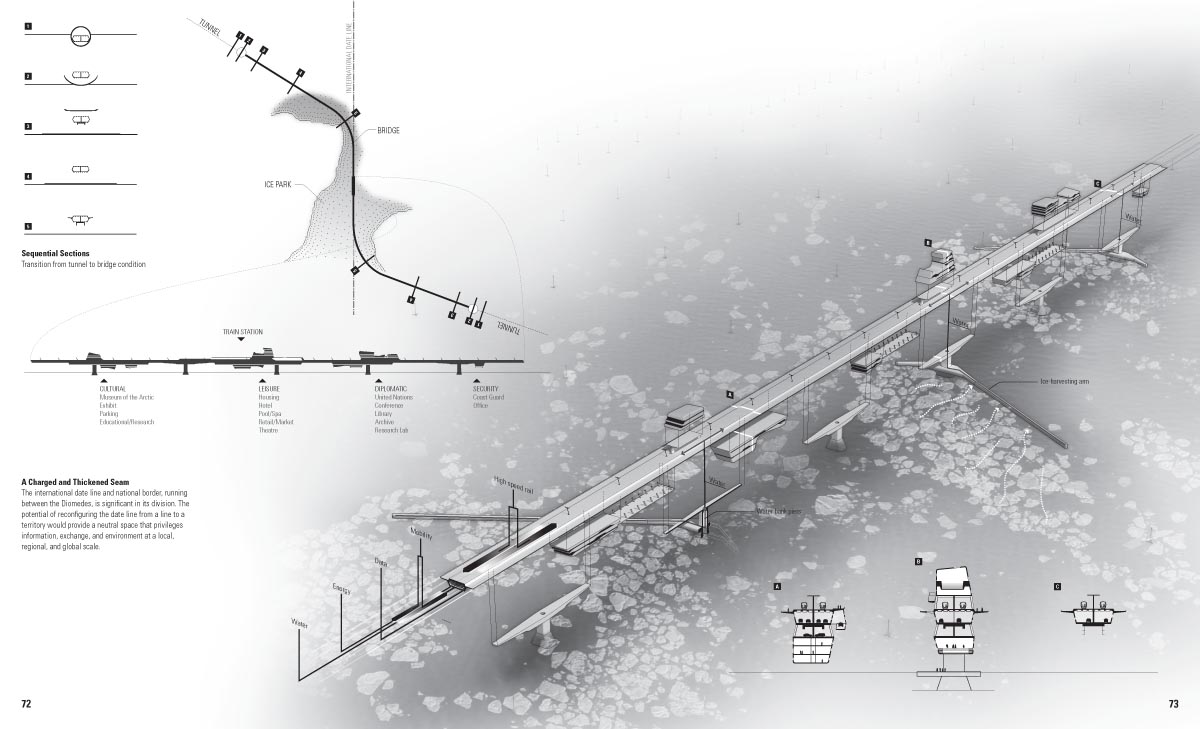 [Images: From Coupling: Strategies for Infrastructural Opportunism by Lateral Office/InfraNet Lab].
[Images: From Coupling: Strategies for Infrastructural Opportunism by Lateral Office/InfraNet Lab].
Essays by David Gissen, Keller Easterling, Charles Waldheim, and Christopher Hight round out the book’s content. It’s a solid pamphlet, both practical and imaginative—made even more provocative by its implied feasibility—and a fantastic choice for the 30th edition of this long-running series.
Drylands Design
 If I could go back in time, there are two things I would have prioritized this autumn, had I known about them earlier: 1) I would have stopped by the Out of Water: Innovative Technologies in Arid Climates exhibition, curated by Liat Margolis and Aziza Chouani, at the Arid Lands Institute of Woodbury University, and 2) I would have attended more of the accompanying lecture series. The whole thing sounds amazing.
If I could go back in time, there are two things I would have prioritized this autumn, had I known about them earlier: 1) I would have stopped by the Out of Water: Innovative Technologies in Arid Climates exhibition, curated by Liat Margolis and Aziza Chouani, at the Arid Lands Institute of Woodbury University, and 2) I would have attended more of the accompanying lecture series. The whole thing sounds amazing.
 Here’s a description of the lecture series:
Here’s a description of the lecture series:
Excavating Innovation: The History and Future of Drylands Design examines the role of water engineering in shaping public space and city form, by using arid and semi-arid sites in India, the Middle East, the Mediterranean, and the New World to explore how dryland water systems throughout history have formed and been formed by ritual, hygiene, gender, technology, governance, markets, and, perhaps above all, power.
The series “brings together historians, urbanists, and contemporary designers to selectively excavate global historical case studies and reveal relevance to contemporary design practice.”
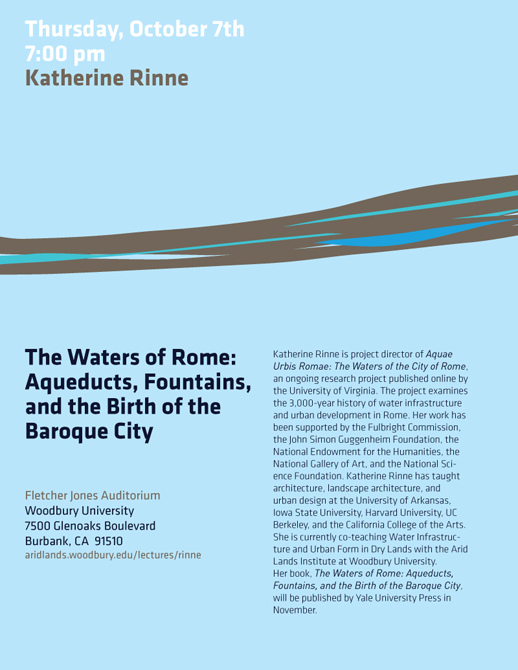

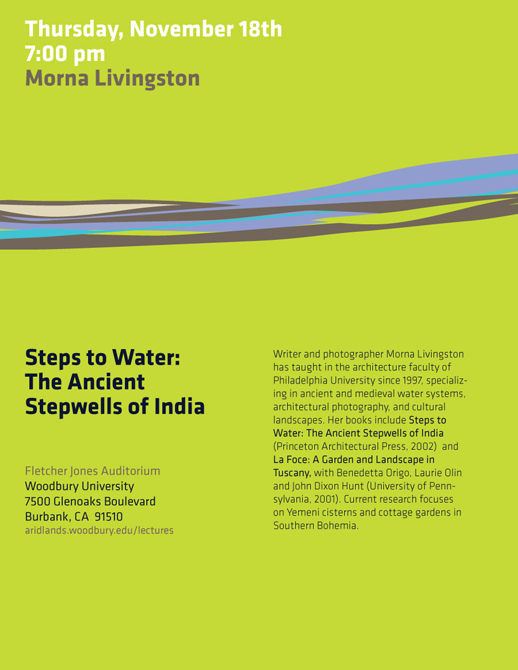 The specific lectures sound almost too good to be true, including a forthcoming talk this Thursday, November 18, about the stepwells of India—fantastically gorgeous native hydrological structures I’ve returned to again and again in my own off-blog reading and research.
The specific lectures sound almost too good to be true, including a forthcoming talk this Thursday, November 18, about the stepwells of India—fantastically gorgeous native hydrological structures I’ve returned to again and again in my own off-blog reading and research.
 [Image: Stepwell at Chand Baori, courtesy of Wikipedia].
[Image: Stepwell at Chand Baori, courtesy of Wikipedia].
The series continues into 2011 with a lecture by Nan Ellin called “Canalscape: Ancient and Contemporary Infrastructures of Phoenix” (January 27) and one by Vinayak Bharne called “Indigenous Infrastructure and the Urban Water Crisis: Perspectives from Asia” (February 10).
Anyone interested in the idea of “drylands design” or arid-climate technologies should strongly consider picking up a copy of Fred Pearce’s excellent book When the Rivers Run Dry: Water, The Defining Crisis of the Twenty-first Century. In it, Pearce presents a huge variety of vernacular water-harvesting and storage architectures, from Chinese domestic cisterns and dew ponds in the English South Downs to fog-catching nets in Pacific South America. Two other quick suggestions, if you want to extend your reading, include Marc Reisner’s classic Cadillac Desert: The American West and Its Disappearing Water—an immensely interesting but often historically over-detailed book—and James Powell’s Dead Pool: Lake Powell, Global Warming, and the Future of Water in the West. The latter title I favorably reviewed a while back for the The Wilson Quarterly.
In fact, if you’re really into this stuff, another article I frequently recommend here is something published in the Chicago Reader back in 2006: “They need it, we waste it,” a provocative look at the future interstate politics of freshwater, projecting a time when cities like Phoenix, Las Vegas, and even L.A. might come, buckets in hand, begging for clean water from the Great Lakes. What impending hydro-political rearrangement of North America might we then see take shape?
(Follow the Arid Land Institute on Twitter. Earlier on BLDGBLOG: N.A.W.A.P.A.).
An Invisible Empire of Sidewalks and Gutterspace
 [Image: The Viele Map].
[Image: The Viele Map].
Because of a talk I’ll be giving tonight at the USC School of Architecture with Nicola Twilley of Edible Geography, I found myself re-reading an old post here about fishing in the basements of Manhattan.
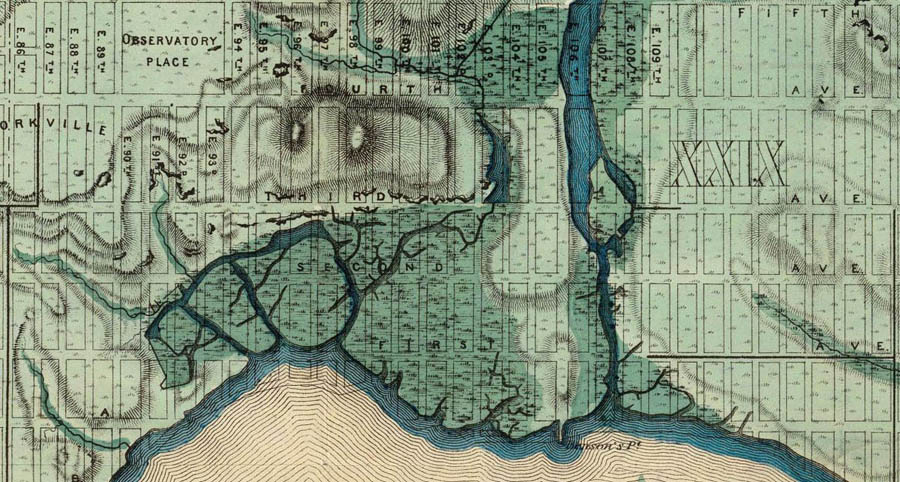 [Image: The Viele Map].
[Image: The Viele Map].
Manhattan being an island once thoroughly criss-crossed by ponds and streams, almost all of which have been sealed in concrete and turned into sewers, this somewhat hallucinatory theory goes that some of those streams might still be accessible: just smash down through your building’s basement floor, uncover the island’s lost hydrology of well-braided rivers and streams, and an angling paradise will be accessible at your feet.
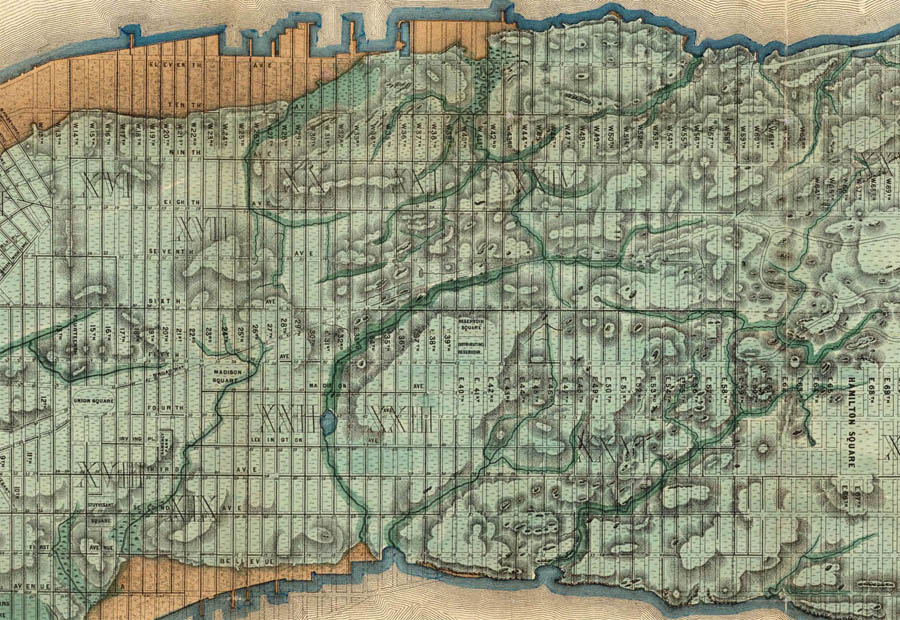 [Image: The Viele Map via Kottke.org].
[Image: The Viele Map via Kottke.org].
But what really caught my eye, and what I’m actually posting about here, is a “gutterspace” reclamation project inaugurated by a man named Jack Gasnick, something I rediscovered today after following a link at the end of that post, which leads to the long-defunct blog Urbablurb by Giles Anthony.
 [Image: From Gordon Matta-Clark’s Fake Estates, via Free Association Design].
[Image: From Gordon Matta-Clark’s Fake Estates, via Free Association Design].
This is how Anthony describes Gasnick’s project:
In the early 1970s—unbelievably, given how influential Gordon Matta-Clark has become in the last few years—Gasnick began buying and collecting “gutterspace,” or small slivers of land left over from zoning or surveying errors. He said that after a little while he couldn’t stop: “It’s like collecting stamps; once you’ve got the fever, you’ve got the fever.”
Accordingly, Gasnick “bought a slice in Corona just behind Louis Armstrong’s house,” Urbablurb continues, “a piece near Jamaica Bay where he once filled a pail with sea-horses, and yet another adjacent to the Fresh Kills landfill where he claims an abandoned sea Captain’s house still stood.” Gasnick then cultivated small patches of parkland and wilderness within those areas—a micro-wilding of the metropolis, one site at a time: “On the weekends, he would sometimes drive out to the tiny parcels and help the milkweed and laurel grow, tend to the turtles, and sit down for a picnic. ‘This jump of mine from flower pot to apple tree bears witness to the fact that it doesn’t cost much for an apartment-living guy to get a share of the good environment,’ he wrote in 1974. To be exact, it cost between $50 and $250. But the taxes he had to pay were enough of a hassle that he gave away (or otherwise lost track of) all the pieces by 1977.”
He “lost track” of them—the mind reels at the possibility that there is still a distributed Jack Gasnick estate somewhere, peppering the streets and gutters of New York City.
As Anthony suggests, this all has an uncanny parallel in Gordon Matta-Clark’s Fake Estates project. From Cabinet magazine:
In the early 1970s, Matta-Clark discovered that the City of New York periodically auctioned off “gutterspace”—unusably small slivers of land sliced from the city grid through anomalies in surveying, zoning, and public-works expansion. He purchased fifteen of these lots, fourteen in Queens and one in Staten Island. Over the next years, he collected the maps, deeds, and other bureaucratic documentation attached to the slivers; photographed, spoke, and wrote about them; and considered using them as sites for his unique brand of “anarchitectural” intervention into urban space.
So who is Jack Gasnick, that minor New Yorker who once “bought strange-shaped lots in every borough,” as the New York Times reported back in 1994, when Gasnick was still alive and 74 years old, and who once claimed to fish in the basements of Manhattan? Who knows.
(The BLDGBLOG/Edible Geography presentation tonight at USC is at 6pm in Harris Hall; it’s free and open to the public. We’ll be talking about buried rivers, artificial glaciers, and quarantine, among other shared topics of interest).
An edge over which it is impossible to look
 [Image: The Ladybower bellmouth at full drain, photographed by Flickr user Serigrapher].
[Image: The Ladybower bellmouth at full drain, photographed by Flickr user Serigrapher].
Nearly half a year ago, a reader emailed with a link to a paper by Andrew Crompton, called “Three Doors to Other Worlds” (download the PDF). While the entirety of the paper is worth reading, I want to highlight a specific moment, wherein Crompton introduces us to the colossal western bellmouth drain of the Ladybower reservoir in Derbyshire, England.
His description of this “inverted infrastructural monument,” as InfraNet Lab described it in their own post about Crompton’s paper—adding that spillways like this “maintain two states: (1) in use they disappear and are minimally obscured by flowing water, (2) not in use they are sculptural oddities hovering ambiguously above the water line”—is spine-tingling.
 [Image: The Ladybower bellmouth, photographed by John Fielding, via Geograph].
[Image: The Ladybower bellmouth, photographed by John Fielding, via Geograph].
“What is down that hole is a deep mystery,” Crompton begins, and the ensuing passage deserves quoting in full:
Not even Google Earth can help you since its depths are in shadow when photographed from above. To see for yourself means going down the steps as far as you dare and then leaning out to take a look. Before attempting a descent, you might think it prudent to walk around the hole looking for the easiest way down. The search will reveal that the workmanship is superb and that there is no weakness to exploit, nowhere to tie a rope and not so much as a pebble to throw down the hole unless you brought it with you in the boat. The steps of this circular waterfall are all eighteen inches high. This is an awkward height to descend, and most people, one imagines, would soon turn their back on the hole and face the stone like a climber. How far would you be willing to go before the steps became too small to continue? With proper boots, it is possible to stand on a sharp edge as narrow as a quarter of an inch wide; in such a position, you will risk your life twisting your cheek away from the stone to look downward because that movement will shift your center of gravity from a position above your feet, causing you to pivot away from the wall with only friction at your fingertips to hold you in place. Sooner or later, either your nerves or your grip will fail while diminishing steps accumulate below preventing a vertical view. In short, as if you were performing a ritual, this structure will first make you walk in circles, then make you turn your back on the thing you fear, then give you a severe fright, and then deny you the answer to a question any bird could solve in a moment. When you do fall, you will hit the sides before hitting the bottom. Death with time to think about it arriving awaits anyone who peers too far into that hole.
“What we have here,” he adds, “is a geometrical oddity: an edge over which it is impossible to look. Because you can see the endless walls of the abyss both below you and facing you, nothing is hidden except what is down the hole. Standing on the rim, you are very close to a mystery: a space receiving the light of the sun into which we cannot see.”
 [Image: The Ladybower bellmouth, photographed by Peter Hanna, from his trip through the Peak District].
[Image: The Ladybower bellmouth, photographed by Peter Hanna, from his trip through the Peak District].
Crompton goes on to cite H.P. Lovecraft, the travels of Christopher Columbus, and more; again, it’s worth the read (PDF). But that infinitely alluring blackness—and the tiny steps that lead down into it, and the abyssal impulse to see how far we’re willing to go—is a hard thing to get out of my mind.
(Huge thanks to Kristof Hanzlik for the tip!)
Hexagonal Hydropolis
 [Image: From Sietch Nevada by Matsys; renderings by Nenad Katic].
[Image: From Sietch Nevada by Matsys; renderings by Nenad Katic].
Andrew Kudless of Matsys recently proposed an extraordinary desert city of semi-subterranean terraces inspired by the novel Dune.
The images are fantastic, and the project description hooked me right away:
In Frank Herbert’s famous 1965 novel Dune, he describes a planet that has undergone nearly complete desertification. Dune has been called the “first planetary ecology novel” and forecasts a dystopian world without water. The few remaining inhabitants have secluded themselves from their harsh environment in what could be called subterranean oasises. Far from idyllic, these havens, known as sietch, are essentially underground water storage banks. Water is wealth in this alternate reality. It is preciously conserved, rationed with strict authority, and secretly hidden and protected.
The rest of the project combines an interest in drought hydropolitics in the U.S. southwest with the speculative architecture of “underground water banks.”
 [Image: From Sietch Nevada by Matsys; renderings by Nenad Katic].
[Image: From Sietch Nevada by Matsys; renderings by Nenad Katic].
Continuing to quote at length:
Although this science fiction novel sounded alien in 1965, the concept of a water-poor world is quickly becoming a reality, especially in the American Southwest. Lured by cheap land and the promise of endless water via the powerful Colorado River, millions have made this area their home. However, the Colorado River has been desiccated by both heavy agricultural use and global warming to the point that it now ends in an intermittent trickle in Baja California. Towns that once relied on the river for water have increasingly begun to create underground water banks for use in emergency drought conditions. However, as droughts are becoming more frequent and severe, these water banks will become more than simply emergency precautions.
Accordingly, Kudless suggests that “waterbanking” will become “the fundamental factor in future urban infrastructure in the American Southwest.”
In this context, I would unhesitatingly recommend Marc Reisner’s classic book Cadillac Desert – the first hydrological page-turner I’ve ever read – as well as James Lawrence Powell’s recent Dead Pool: Lake Powell, Global Warming, and the Future of Water in the West (which I reviewed for The Wilson Quarterly earlier this year). Those two books are ideal references for Matsys’s project, as they each supply countless examples of hubristic, quasi-imperial waterbanking projects – projects that might still be functioning today but that are doomed, the authors convincingly show, to eventual dehydration.
Powell, in particular, offers genuinely disturbing descriptions of the looming silt-deposits that have accumulated behind the dams of the American west, amongst often extraordinarily poetic overviews of these dams’ inevitable failure. “One day every trace of the dams and their reservoirs will be gone,” Powell writes, “a few exotic grains of concrete the only evidence of their one-time existence.”
 [Image: Matsys’s Sietch Nevada as seen from above; renderings by Nenad Katic].
[Image: Matsys’s Sietch Nevada as seen from above; renderings by Nenad Katic].
In any case, the proposal seen here is “an urban prototype,” we read, “that makes the storage, use, and collection of water essential to the form and performance of urban life.”
A network of storage canals is covered with undulating residential and commercial structures. These canals connect the city with vast aquifers deep underground and provide transportation as well as agricultural irrigation. The caverns brim with dense, urban life: an underground Venice. Cellular in form, these structures constitute a new neighborhood typology that mediates between the subterranean urban network and the surface level activities of water harvesting, energy generation, and urban agriculture and aquaculture. However, the Sietch is also a bunker-like fortress preparing for the inevitable wars over water in the region.
Check out the full project on Matsys’s own website – and, while you’re there, the entire project database is worth a spin.
(Spotted on Architecture MNP. And read Dune!)
The Water Menu
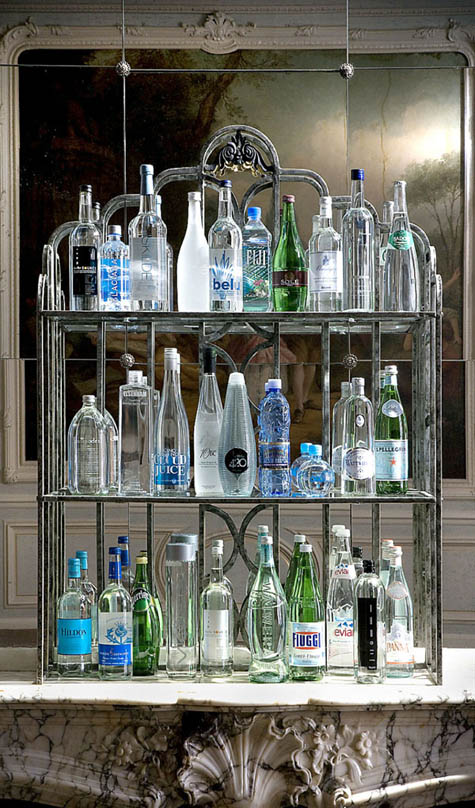 [Image: The water selection at Claridge’s, curated by Renaud Grégoire, food and beverage director].
[Image: The water selection at Claridge’s, curated by Renaud Grégoire, food and beverage director].
Note: This is a guest post by Nicola Twilley.
The concept of terroir has its origins in French winemaking, as a means to describe the effect of geographic origin on taste. As a shorthand marker for both provenance and flavor, and as a sign of its burgeoning conceptual popularity, it has spread to encompass Kobe beef, San Marzano tomatoes, and even single-plantation chocolate.
But can water have terroir? What about the influence of the earth on water?
In late 2007, Claridge’s (a luxury hotel in Mayfair, London) caused a minor stir by introducing a “Water Menu.” The list features more than thirty mineral waters from around the world, described in terms of their origin and suggested flavor pairings.
Leaving aside a few obvious issues (such as the environmental impact of bottled water and the sheer economic wastefulness of sending multiple varieties of it to one hotel in England), it is hard not to appreciate the poetry of three-line exotic water biographies.
Take Mahalo Deep Sea Water, at £20 for 71cl, which comes from “a freshwater iceberg that melted thousands of years ago and, being of different temperature and salinity to the sea water around it, sank to become a lake at the bottom of the ocean floor. The water has been collected through a 3000ft pipeline off the shores of Hawaii.” According to the Daily Mail, Mahalo has a “very rounded quality on the palate” and it “would be good with shellfish.”
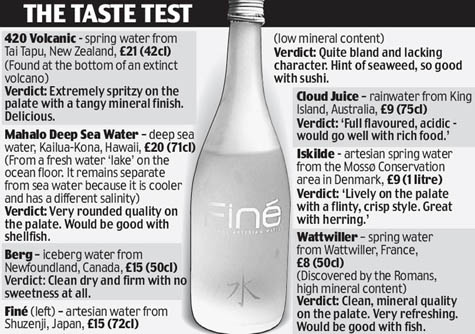 [Image: The Daily Mail‘s taste test results].
[Image: The Daily Mail‘s taste test results].
Meanwhile, Danish Iskilde‘s “flinty, crisp style” apparently derives from the Jutland aquifer’s complicated geology, consisting of interlaced deposits of quartz sand, clay, gravel, and soil. The most expensive (and possibly the most exciting) water on the menu is 420 Volcanic from New Zealand. Sourced from the Tai Tapu spring, which bubbles up through more then 650 feet of rock at the bottom of an extinct volcano, it is apparently “extremely spritzy on the palate with a tangy mineral finish.”
Claridge’s has since been joined by the Four Seasons in Sydney, and, according to The Guardian, “a handful of five-star Los Angeles hotels now employ water sommeliers to advise on the best water accompaniment to spiced braised belly pork or fillet of brill with parmentier of truffled leek.”
This same Guardian article goes on to recount the origins of Elsenham Water, which is described as “absolutely pure” and “very earthy—almost muddy,” depending on who you ask. Elsenham was discovered almost accidentally by Michael Johnstone, a former jam manufacturer; it is filtered over a 10-year period, in a confined chalk aquifer, half a mile below his abandoned jam factory and a neighboring industrial-sealant plant. Now, staff in white coats and hair nets fill up to 1,000 bottles daily “from an acrylic tank connected to pipes running into a hole in the ground.” Each bottle, priced at £12 for 75cl, is then polished by hand before it leaves the building.
According to Michael Mascha, former wine critic and author of Fine Waters: A Connoisseur’s Guide to the World’s Most Distinctive Bottled Waters, “water is in a transition from being considered a commodity to being considered a product.”
There is an undeniable Wild West gold-rush type of excitement to the idea of drilling for water in geologically auspicious locations. However, Mascha’s comment also implies that we might even begin to see the engineering of gourmet water products.
Loop tap water in a closed pressurized system for twenty years, through thick beds of pure northern Italian dolomite, and enjoy the lightly acidic result with chicken and fish. Better yet, blend it with water forced through a mixture of Forez and Porphyroid granite chips sourced from southwest France, stacked in a warehouse outside London to mimic in situ geological formations, to add a citrusy top note reminscent of Badoit.
A final spritz of oxygen ensures a silky mouthfeel—combined with the right designer packaging—and the burgeoning ranks of water connoisseurs will be lining up at your industrial plant for a taste.
[Previous posts by Nicola Twilley include Atmospheric Intoxication, Park Stories, and Zones of Exclusion].







